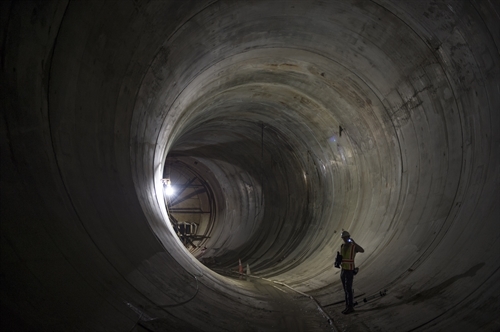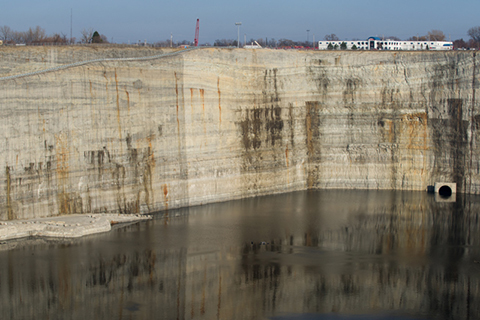
We’ve made huge strides improving Calumet area water quality—next up is Chicago
The Chicago River has been getting a bad rap lately as a waterway that “teems with bacteria flushed from sewers” after heavy storms which lead to combined sewer overflow (CSO) events. With all the summer storms and severe flooding lately, this was certainly an eye-catching news headline.
But, there is one river system that has gotten cleaner in key ways since 2015, one that we don’t always hear about. Can you guess which one? Thanks to a massive hole in the ground and the power of chlorine, the Calumet River System’s water quality has improved in noticeable ways.

Metropolitan Water Reclamation District
3.75 million people will benefit from TARP’s collective improvements to water quality.
The Metropolitan Water Reclamation District of Greater Chicago (MWRD), our regional stormwater and wastewater treatment agency, has made significant strides in two distinct-but-powerful efforts that address Calumet-area water quality through better stormwater management and wastewater treatment: 1. the Thornton Reservoir, part of the Tunnel and Reservoir Plan (TARP), a system of deep tunnels and massive reservoirs and 2. disinfection at the Calumet Water Reclamation Plant (WRP).
“The investments the MWRD has made in protecting our waterways has yielded positive results, and today we are in compliance with direct contact for many parts of the waterway system based on Environmental Protection Agency’s standards” said MWRD President Mariyana Spyropoulos.
As a result, we are seeing more recreational users enjoy the Calumet-area waterways, which include the Calumet River, the Little Calumet River, the Grand Calumet River and the Cal-Sag Channel. How did the Calumet River System get so much cleaner in just a few years?
Thornton Reservoir: a milestone of TARP that protects more than 550,000 people from polluted water
TARP is a system of 109 miles of deep, large-diameter tunnels and three vast reservoirs designed to reduce flooding and improve water quality for 3.75 million people. TARP captures and stores combined stormwater and sewage that would otherwise overload the sewer system, causing overflows into waterways, like our rivers, in rainy weather (a.k.a. CSO events). Instead, the water captured and stored is eventually pumped back to the water reclamation plants to be cleaned before it’s released to the waterways.

Metropolitan Water Reclamation District
MWRD began constructing TARP in 1975 in two phases, tunnels followed by reservoirs. The entire tunnel system was operational in 2006. As for the reservoirs, the smallest (called the Gloria Alitto Majewski Reservoir) was completed in 1998 and the Thornton Reservoir, south of the Calumet River, was completed in 2015. The McCook Reservoir in Bedford Park is slated to be fully completed by 2029.
How has TARP affected local water quality thus far?
Since 2006 when only the tunnel portion of TARP was complete, the number of CSO events to the watercourses within the MWRD’s service area—including the Chicago Area Waterway System but also Salt Creek, Addison Creek Weller Creek, Feehanville Ditch and the Des Plaines River—was cut in half, preventing an estimated 85 percent of the CSO pollution that would have occurred absent the tunnels, according to data provided by MWRD for this blog. And that’s just the tunnels.
As far as reservoirs go, the enormous Thornton Reservoir—the size of 12 Soldier Fields!—came online in 2015 and added to the TARP water quality improvements momentum. Thornton can hold 7.9 billion gallons of water and services the Calumet River System. Check out this timelapse footage of Thornton’s first fill during a storm back in November 2015. Thornton has since served the South Side of Chicago and many south suburbs in Cook County to reduce CSO events in the entire Calumet River System down to only three reported instances between August 2016 and March 2017.

Metropolitan Water Reclamation District
The size of 12 Soldier Fields, the Thornton Reservoir that can hold 7.9 billion gallons of water.
As you can see by the graph below, that is quite an improvement in Calumet River System CSO activity. “As we compile new data from Thornton, we will be able to make statistically significant conclusions about the impact of TARP on water quality,” said MWRD President Spyropoulos.
Since Thornton came online, the most water the reservoir has handled was about 2.8 billion gallons, or 35% of its capacity, from a rainy 10-day period back in April 2017. If we had experienced the storms like those of Lake County in July 2017, we would have used closer to 70% of Thornton’s capacity. In general, stormwater controls like Thornton will be further stressed due to the effects of climate change.

Metropolitan Water Reclamation District
The public health benefits of disinfecting wastewater at Calumet plant
Thanks to the wastewater treatment step of disinfection, bacteria and other microbes found in treated water are neutralized or killed, reducing the risk of human health problems resulting from direct contact with the water that eventually gets released from said treatment plant into the river.
At the Calumet WRP, MWRD finishes its wastewater treatment process with disinfection through a “chlorination/de-chlorination” process. The chlorination process decimates the bacteria in the wastewater and the de-chlorination step reduces the residual chlorine to make sure the discharge to the river does not harm fish.
MWRD began disinfection in 2016 at the Calumet WRP on the Far South Side. Since then, monitoring stations have recorded a significant decrease in fecal coliform concentration, one indicator of bacterial contamination, downstream of the Calumet WRP along the Little Calumet and the Cal-Sag Channel.
According to MWRD data collection from the Halsted Street monitoring location on the Little Calumet River that took samples pre- and post-disinfection between March 2015 and November 2016, the amount of monthly fecal coliform had been reduced between 82.0%-99.9%.
More recently, a sample collected at the same location on June 26, 2017 recorded 60 colony-forming units (CFUs) per 100 milliliters of fecal coliform. Compare that number to the highest recorded sample—from March 2015—39,000 CFUs per milliliter. Your eyes pop at the significant improvement to downstream areas as far as bacterial water quality after disinfection.
The U.S. EPA has recommended fecal coliform as a criteria for water quality since 1976. Over time, other indicators have emerged and are increasingly being used, such as monitoring for specifically E. coli or other microbial indicators. While it remains useful to measure fecal coliform levels in order to see trends from historic data, it is just one quantifiable variable in a much broader picture of water quality.
For more qualitative proof of the cleanliness of the Calumet area waterways, my colleague Josh Ellis (and MWRD Executive Director David St. Pierre, among a few others) jumped into the Cal-Sag Channel twice in the last two years and lived to tell the tale!
Avoiding $143M in flood damages and improving Chicago River water quality is closer than you think
So far, I’ve been recapping progress along the Calumet River waterways. I know what you’re thinking. What about the Chicago River? Well, we have much to look forward to.
The McCook Reservoir is slated to be fully operational in 2029 when it will help 37 communities by providing more than $143 million per year in flood damage reduction benefits to 3,100,000 people in addition to the water quality benefits from the decrease in combined sewer overflows.
When fully up and running, McCook will serve various Chicago waterways, including the North Branch of the Chicago River, the Chicago River, the South Branch of the Chicago River, South Fork of the South Branch of the Chicago River, Chicago Sanitary and Ship Canal, Collateral Channel, Salt Creek, Addison Creek and the Des Plaines River!

McCook Reservoir is slated to be fully operational in 2029 when it will help 37 communities.
On the water capacity front, McCook will reach a total capacity of 10 billion gallons of water. Line up 15,000 Olympic-size swimming pools and that’s roughly how much water can be stored by McCook when finished.
Lucky for us, McCook Stage 1 will be completed in 2017 (that’s this year, folks!) and provide 3.5 billion gallons of storage. From this step alone, we can expect the number of CSO events in the Chicago River, and elsewhere McCook serves, to substantially decrease.
Here’s a final bit of good news to keep on the radar: MWRD is partnering with scientists from the U.S. Department of Energy’s Argonne National Laboratory in a seven-year study of the microbial communities in the Chicago Area Waterway System to provide comprehensive insight into the ecology of one of the largest, man-made and natural urban river systems.
“Microbial communities are key players in maintaining the health of the riverine ecosystem, with profound implications on public health, environmental management and economic growth for the City of Chicago” said Mel Dsouza, Scientist at Argonne National Laboratory and the University of Chicago.
Watch this four-minute video to learn more about this microbiome project for the Chicago River. Already, results from the first three years of the study are indicating that Chicago area waterways have healthy and diverse microbial communities, which is critical for helping maintain a healthy river.
MPC and many of our partners working toward cleaner rivers believe that connecting these large-scale gray infrastructure projects and water treatment processes with nature-based solutions, like green infrastructure, will help in continuing to see progress in water quality that benefits our local communities. Check out how MPC is helping to drive regional initiatives that benefit our rivers and our communities through Great Rivers Chicago and the Calumet Stormwater Collaborative.
While it’s true we have a lot of work to do, I hope this message also makes the headlines: we have made progress on improving the water quality in our river systems, with much more to come.